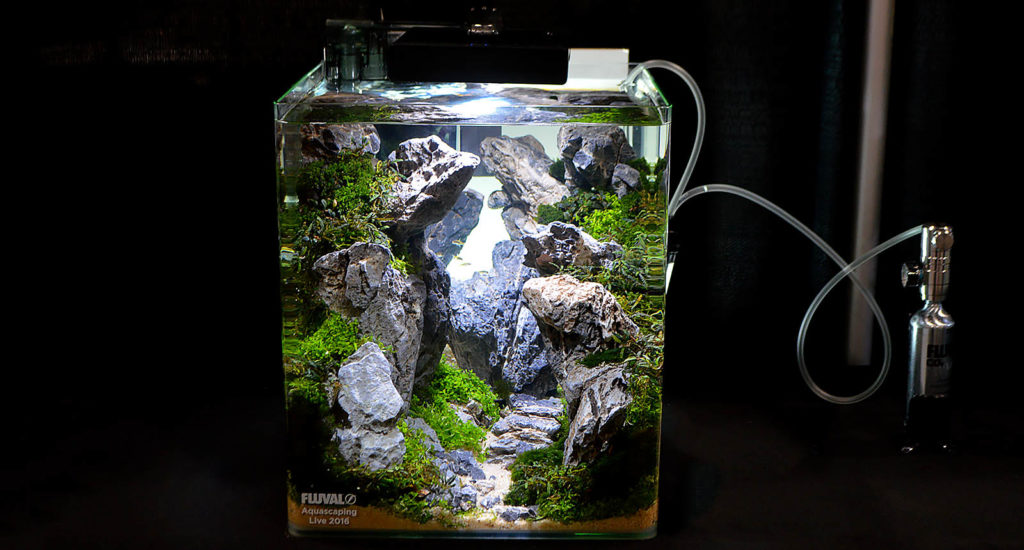
John Pini’s nano aquascape title Guidance took Best in Show in the nano division of the Aquascaping Live! competition at the 2016 Aquatic Experience – Chicago. Fluval 7.9-gallon (30-L) tank. Image credit: Matt Pedersen
Aquascaping jumped out of the special-interest groups and became a mainstream feature of the aquarium hobby when the inaugural Aquascaping Live! competition was launched at the 2014 Aquatic Experience – Chicago. With the third annual Aquascaping Live! in 2o16, the competition grew in terms of participants, and the bar was raised with a field of strong offerings. (Well, to be fair, it’s probably more appropriate to say the bar was left a mangled and twisted pile of iron, cast aside by the hands of amateur aquascaper John Pini.)
Pini: An Aquascaper to Watch
John Pini, an Illinois native just 25 years old, arguably dominated the nano tank competition at the 2016 Aquascaping Live! competition (learn more about the 2016 competition, and see all the entries, in our Aquascaping Live! 2016 Small Tank Photospread). Pini has only been aquascaping for 2 years, and yet he managed to conceive a design that stopped people in their tracks. The first-place, “Best In Show” nano tank entry was a source of conversation all weekend. Even if it wasn’t their absolute favorite aquascape, spectators and commentators were quick to acknowledge the exceptional nature of the design.
There are times you meet someone whom you believe is an up-and-comer, and after meeting Pini, I believe he qualifies for that title. After just 2 years in the aquascaping hobby, and only a year on the competitive circuit, Pini has surrounded himself with exceptional mentors, including Bailin Shaw of the Aquatic Gardeners Association (AGA). Pini is also one of the founding members of the newly-formed Chicago Aquatic Plant Society. We hope to feature more of Pini’s work and his inspired aquascaping philosophy in a future issue of AMAZONAS Magazine. But for now, let’s turn our attention to how Pini took the 2016 Aquascaping Live! nano tank category by storm.
What Changed This Year
Pini entered the 2015 Aquascaping Live! contest, but failed to place out of 14 entries. This year, with 22 participants, the odds of being awarded were even tougher.
Looking back, Pini explained that the challenge was part of the inspiration. “I was really determined to place this time. But I also heard that a lot of well-known aquascapers were flying in [to compete] this year, so I knew the bar was going to be raised. The people that I actually look up to, the people I was seeing online and getting familiar with their work–it was really cool to find out that I was going to compete against them. It also motivated me, made me more excited about the competition.”
Pini had been working on a lushly planted aquarium when he learned that this year’s competition would require aquascapers to create their aquascapes on the show floor (whereas in past years, one could largely construct things prior, and then simply “drop in” the aquascape). The reasoning was simple: competition organizers wanted spectators to be able to watch this creative, constructive process as it happened.
This change in the competition rules caused Pini to scrap his planned design and completely start over. Objectively, this change in rules may have also been the catalyst that rocketed Pini to the top of this year’s competition.
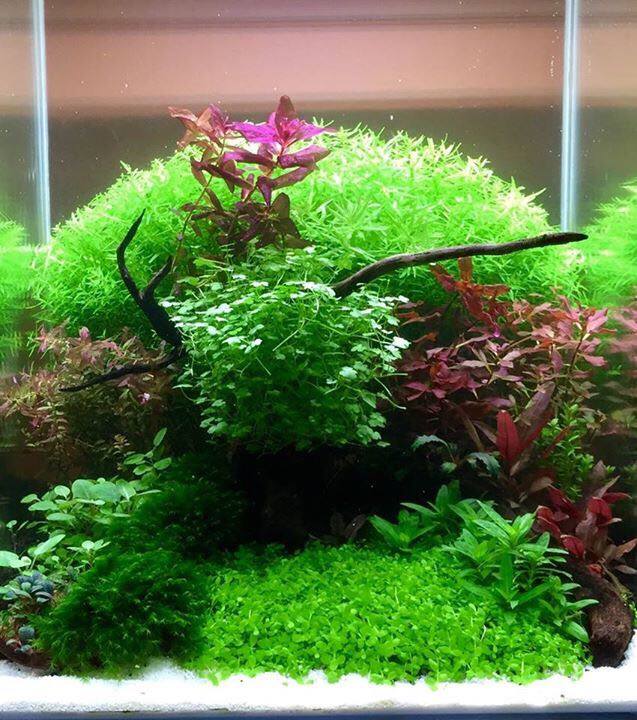
This lushly-planted aquascape could have been John Pini’s nano tank entry at the 2016 Aquascaping Live! competition, but a change in the rules forced Pini to completely rethink his design. Image credit: John Pini
How Pini Adapated
“A lot of people were upset when they made the rule. I just saw it as another opportunity to aquascape. [In] prior years you could bring in completed scapes, but this year, no. You had to build it on the spot so people could see it built [as it happened].”
After tearing down the planted aquarium above, John started over. “I started messing around with the hardscape,” Pini said during our interview. “From the picture, you can tell it’s pretty complex as far as getting things balanced and pieced together. I probably had 30 or 40 different pieces of rock in that tank all said and done; it fits together like a puzzle.”
But how did he create this design? “I’d put sand in the tank and rocks, and play with it without water. I’d get it how I liked it and then go away, come back a few hours later to play with it again. It was probably a week before I was happy with it.”
-
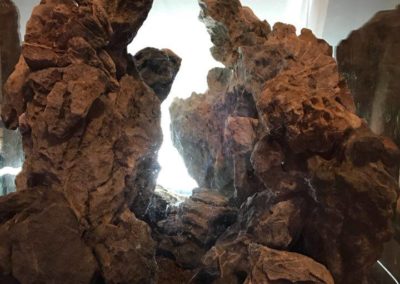
Pini's dry runs at aquascaping, in no particular order. Variation 1. Image credit: John Pini
-
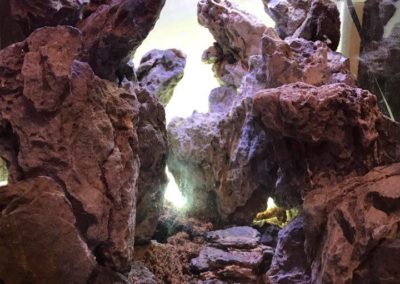
Variation 2. Image credit: John Pini
-
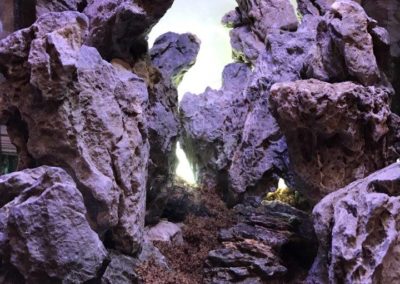
Variation 3. Image credit: John Pini
-
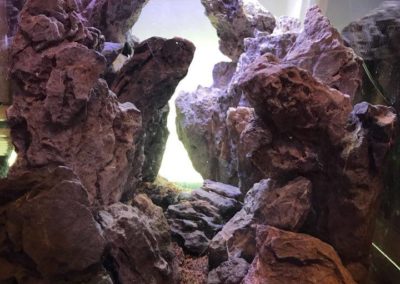
Variation 4. Image credit: John Pini
When it came time to recreate this design on the show floor during the competition, Pini credits his success to practice. “I took it down and put it back together mutliple times before the show. Muscle memory and photos of the tank are what made it come together.”
Keeping the intricate rockwork together was also a challenge. “When I first set up the hardscape, it was all balancing. So at the Aquatic Experience, when I was setting it up, I was using the two-part epoxy to hold a few of the pieces in place, so if someone knocked the tank the whole thing woudln’t collapse.”
Pini’s Aquascaping Materials and Method
For a substrate choice, Pini opted for simple cosmetic sand, in this case pool filter sand. Pini selected a fine-grained sand to emphasize scale. Had this been a normal tank not set up for competition, Pini suggested he would have also incorporated a substrate with nutrients to make maintenance easier.
Pini shared a great substrate tip for aquascapers looking to create depth in their designs: “If you really want depth in your tank, slope [the substrate]. Strategically placed stones or hardscape, or even plastic, can be used as supports for the slope. Once the plants grow in, that helps hold everything in place. The strong slope helps give the illusion of depth.”
The stone used is Seiryu Stone, and most of the plants in the design were grown right on the rock, affixed with either super glue or thread. Some were added at the show, again using gel super glue to attach them to the hardscape so they wouldn’t float away. Pini noted that “it works pretty instantly.”
Pini’s plant choices and design were also made to emphasize the impression of a larger-than-life scale, and to make a natural impression. Pini shared an image that he created during his hardscaping to help envision how the planted tank would look.
“A mistake new aquascapers make is, if you have a carpet of one species of plant, it may look really nice, but it doesn’t necessarily look natural,” Pini said. “A technique I applied to this tank was, I mixed stuff together so it looks natural. When you step out into nature, you have this war of plant life trying to choke out what’s next to it. Creating that sense that different things were growing all over the place, that really helped give this aquascape a natural feel.”
Pini ultimately selected four plant varieties for the aquascape. They included:
- Micranthum sp. “Monte Carlo,” a small green carpeting plant
- Riccardia chamedryfolia, Coral Moss, a darker green liverwort moss which Pini notes is slow growing and beautiful. This fine-leafed plant helps to emphasize the illusion of scale.
- Fissidens fontanus, Phoenix Moss, which creates beautiful dark green pillowy bunches
- Bucephalandra sp. Pini selected a mini variant, possibly the variety known as “Mini Velvet.” It’s a small, dark-leafed plant that grows on a rhizome.
The results largely speak for themselves!
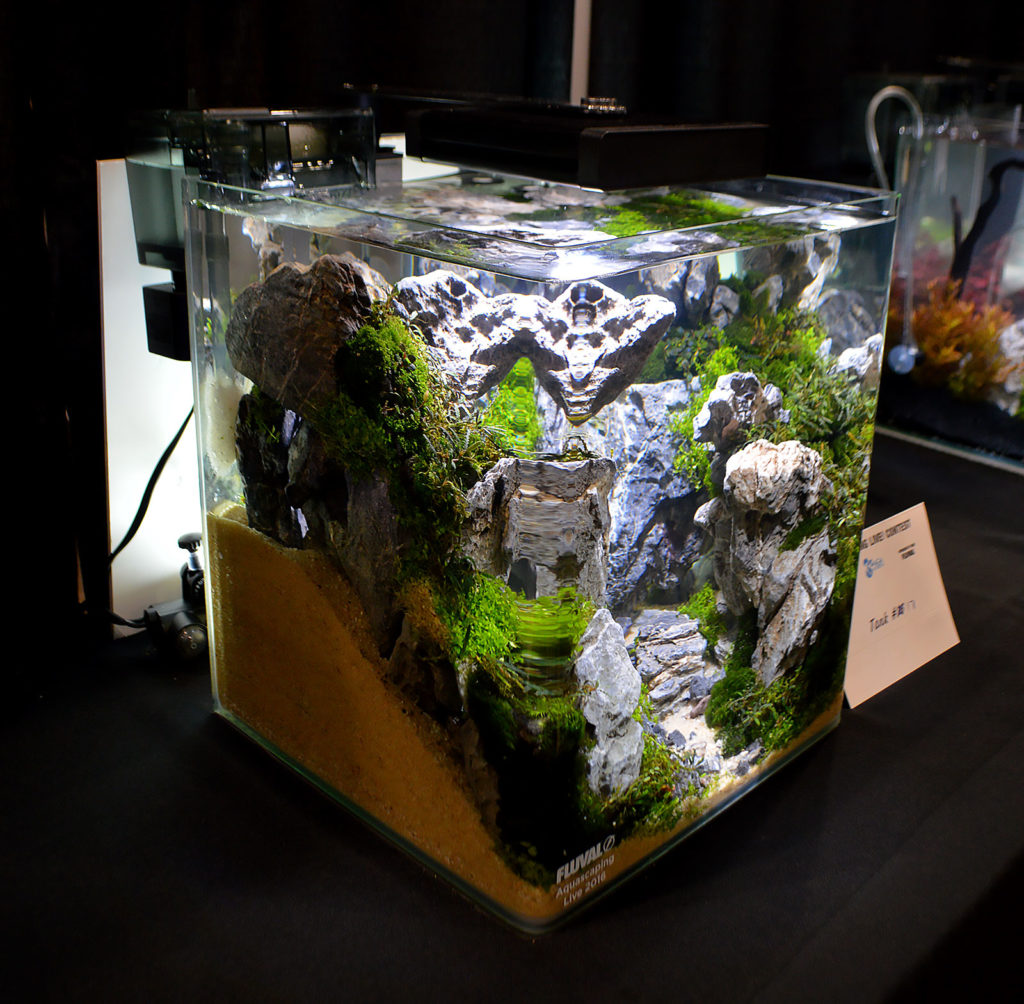
This view from the left shows the strongly sloped substrate and reveals the lit background that aids in creating the illusion of depth in this layout. Image credit: Matt Pedersen
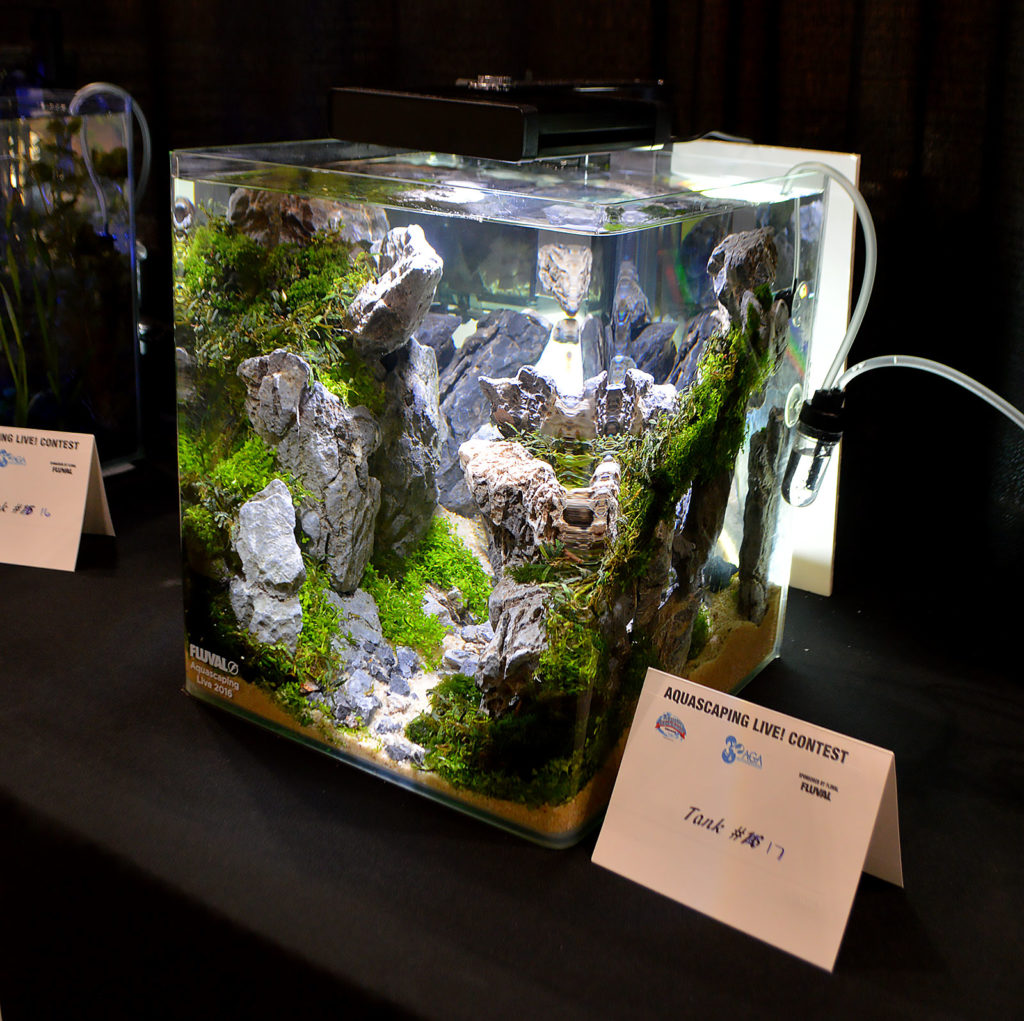
A look at the right side of the aquarium reveals the cave in the back where fish would sometimes seek refuge from the commotion of the convention floor. Image credit: Matt Pedersen
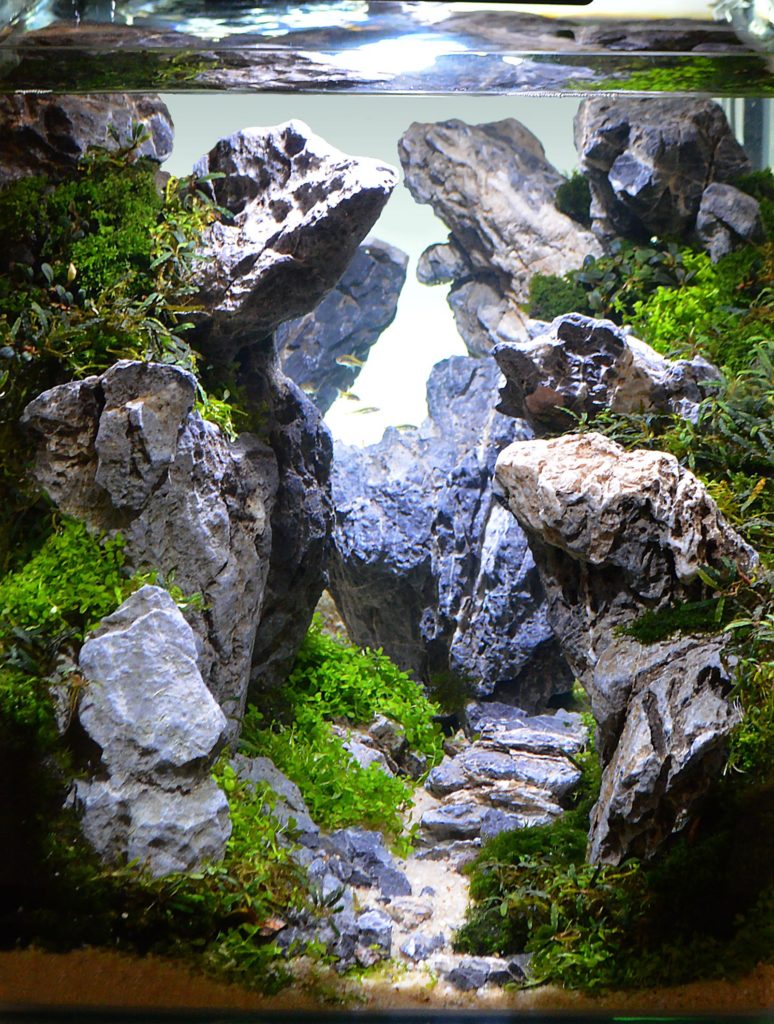
John Pini’s masterpiece, titled Guidance, on the day of judging (we’ve removed the hang on the back filter from this photograph to show you the aquascape as it was meant to be viewed). Image credit: Matt Pedersen
John Pini On Community, Fellowship, and Mentors
“Most aquascapes have a title. My title was Guidance. The reason for it is in honor of the people who’ve helped me along. The biggest thing about any hobby is community and fellowship with other people that have the same interests as you. For me, that’s everything that makes it worth it in the end. If I was at home aquascaping by myself, yeah…(Pini pauses)…but at the end of the day it’s sharing that makes it worth it.”
“When I started a year ago, I didn’t really know anyone else in the world, I didn’t know anyone in the aquarium hobby. I started going to Fish Planet in Deerfield, IL, to get some rare fish and plants. Steven Freed, the shop’s owner, told me, ‘I’m bringing in this guy from the AGA to do an aquascape seminar.’ That turned out to be Bailin Shaw.
“Bailin came in and did a presentation. I think I was so enthusiastic that he knew I was serious about getting into competitive aquascaping, so we stayed in contact. Last year, we decided to start up the Chicago Aquatic Plant Society. He has given me a lot of guidance about how to grow plants, how to look for different things in aquascapes, and the key components that make something compelling, like how do you portray conflict, but also harmony. It looks like it’s all supposed to be there.
“With the online community, too, I’ve made a point to seek out people who are better than me, and sending them my stuff and asking, ‘What do you think of this?’ For the most part, they’re excited about new people getting in; they usually respond with advice and encouragement.
“Jeff Miotke reached out to me last year and gave me a compliment on the tank that didn’t place, and we started talking from there. As a mentor, he doesn’t tell me what to do or what to change, but he tells me what he sees. I think that’s a really important quality of a good mentor: he wants me to put my vision out there, not his. ‘This is what I see, what do you think about that?'”
What Others Had to Say About Pini’s Winning Aquascape
Ted Judy of TedsFishroom.com was the 6th place winner in this year’s competition. In his video recap of the 2016 Aquascaping Live! competition (which includes some interesting tips from Judy), he’s clearly impressed with Pini’s work. Judy’s assessment of the ‘scape? “The very dramatic use of stone to create a canyon is not an easy thing to do in such a small space,” he says, “but it is the creative use of backlighting that makes this design. Your eye is literally dragged deep into the canyon.” (Watch Ted’s video below for his entire view on the aquascaping competition, or start at 5:20 for his look at Pini’s tank.)
Aquascaping is definitely attracting young aquarists. Sixteen-year-old Kent Ross of East Allen Aquatics gave John Pini’s Aquascape an in-depth look during his video recap of the 2016 Aquascaping Live! competition. “So this is our favorite tank right here. It’s got that rocky mountain sides. This is Fort Wayne Fishtank’s and my favorite one. You look right in it, it looks like you’re looking on forever. You can’t tell where the end is. There is only one problem I have with this, and that’s that there’s a little hole in the back which all the fish like to hide out in. So it’s hard to actually get to see some action in the front. But other than that, it’s a really amazing ‘scape with a lot of depth and great action on the sides. What this person did is he added a highlight in the background, kinda flipped it up with a white background here, to give you some intense action in the back to show that it’s never-ending.” (Watch on YouTube – start at 5:49 for Pini’s tank.)
Aquarium Co-Op was also impressed. “Wow, look at this one. Super rock hardscape came out really cool. You know they’ve got it attached to the sides there. I think they built the structures to drop in like that [Editor’s Note – Pini didn’t]. You can see the Exclamation Point Microrasboras kinda in the back hiding out. There’s a lot of poeple walking around, but I bet they do come out front…pretty sweet.” (Watch on YouTube – start at 1:13 for Pini’s tank.)
L.R. Bretz’s Aquatics shared enthusiasm for Pini’s Aquascape. “Now this one, this is pretty awesome. Lot of depth, lot of depth. This is probably one of my favorites here. Look at all that! A lot of plant variety. That’s pretty nice.” (Watch on YouTube – start at 10:31 for Pini’s tank.)
Shrimp specialist Robert Lupton, AKA LupDiesel, kept his praise short and sweet: “So this one got first place, and rightfully so!” (Watch on YouTube – start at 2:12 for Pini’s tank.)
Of course, this photo shared with us by Pini perhaps represents some of the highest praise a rookie could receive in an aquascaping competition.
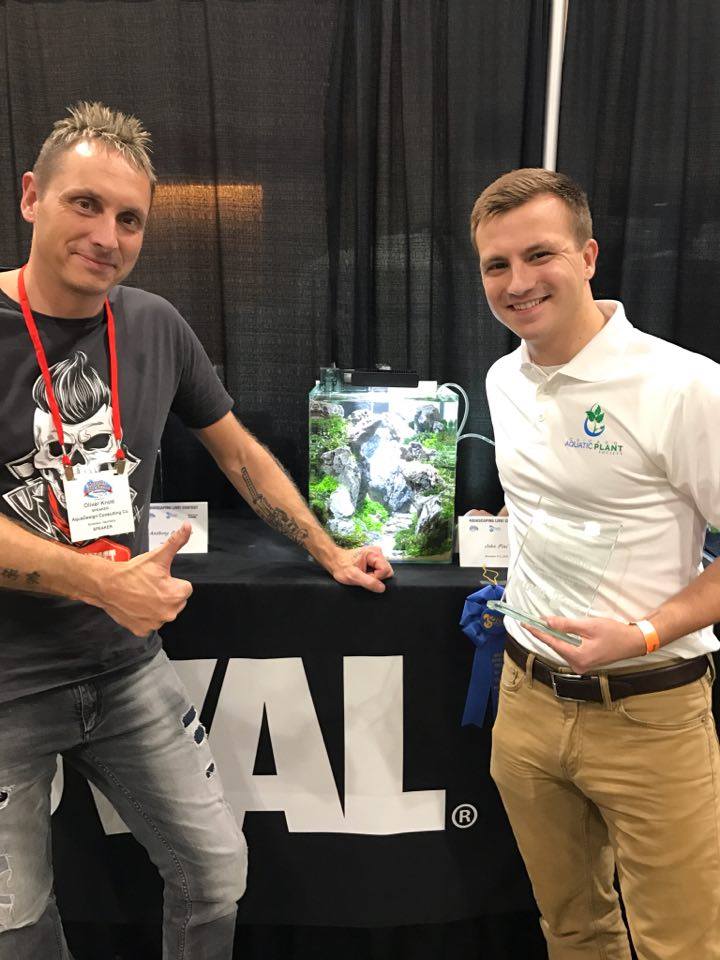
John Pini (right) stands with aquascaping mogul Oliver Knott and Pini’s winning aquascape. A thumbs up from Knott says it all. Image credit: John Pini
Where Is This Amazing Aquascape Now?
Considering Pini’s view of aquascaping as artistic expression, it stood to reason that most painters sell their completed artwork, if for no other reason than to continue to fund future artwork. What if someone had wanted to purchase Pini’s aquascape?
Once again, Pini had an interesting reply. “Given the materials and time in it, I probably would’ve had to sell the tank for $400. What I wouldn’t want to do is sell that tank to someone and have it fail. It would be discouraging. I would’ve profited from it and they would’ve not.”
We asked Pini if he kept this winning aquascape running, if we’d see more of it.
“No, I took it down already,” said Pini. “So it ran for about a week [after the show]. I stuffed garbage bags in the tank [to keep the aquascape in place] and took it home. I had a decision to make, to keep running it and let it grow in, or to tear it down and start something new. As hard as it was to tear it down, that tank, that aquascape, was for that contest. I achieved what I wanted to with it. It was time to do something better.”
And now we all wait to see what “something better” could be when combined with the rookie talent of John Pini.

One more look inside John Pini’s winning aquascape from the Small Tank division at the 2016 Aquascaping Live! competition. Image credit: Matt Pedersen
Resources:
Aquatic Gardeners Association (AGA) – www.aquatic-gardeners.org
Chicago Aquatic Plant Society – www.chicagoaquaticplants.com
Aquatic Experience – Chicago – www.aquaticexperience.org

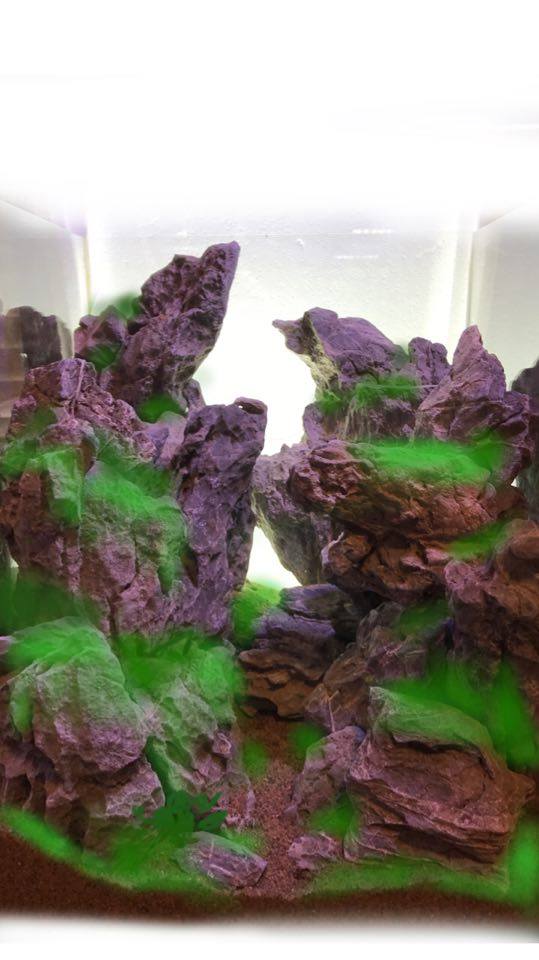





Thank to for sharing MR..Nice article..Bokmark